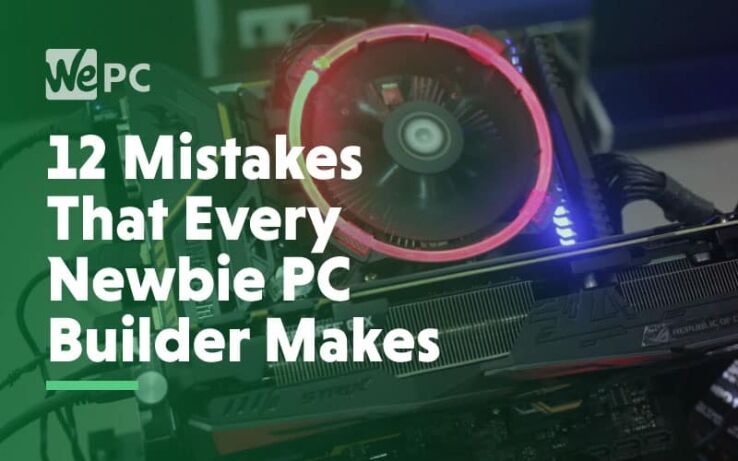12 Mistakes That Every Newbie PC Builder Makes

WePC is reader-supported. When you buy through links on our site, we may earn an affiliate commission. Prices subject to change. Learn more
Building a PC isn’t too difficult, but for a first-timer, it can be a nerve wracking experience. Fortunately, most first-time mistakes aren’t too extreme, and if you’re armed in advance with knowledge of what not to do, chances are your building experience will go much better. Keep reading to learn the mistakes that everyone makes, and how to avoid them yourself.
Forgetting standoff screws
Standoff screws keep your motherboard attached to your case, and by extension your entire PC held together. Unfortunately, they’re easy to forget or screw up. Be sure to properly insert and manage your standoff screws before mounting any components onto your motherboard! There’s nothing worse than putting everything together, only to realize you have to re-do the standoff screws.
Forgetting the motherboard IO shield
Your motherboard will come with a little IO shield for you to plug into your case. This is meant to be inserted BEFORE mounting your motherboard, not after. Mounting it after is incredibly difficult, if not impossible in some situations. Don’t forget this!
Forgetting to plug everything in
Before turning on your PC, make sure EVERYTHING is plugged in and accounted for. Many forget to plug in the CPU or motherboard power connector, and these are both vital for your PC’s safe operation. Ensure all cables are safely plugged and connected before attempting to turn on your PC. Also, don’t forget to flip on your power supply switch!
Plugging video cable into motherboard instead of graphics card
This is a common mistake for first-time builders, but be sure to plug your HDMI/DVI/etc cables into your graphics card instead of your motherboard’s included video ports.
Building on an unsafe surface
Be sure to build on a safe, non-conductive surface, like a wooden table. Also make sure you aren’t on carpet, as that conducts static which could shock your components. If you can afford it, an anti-static wrist strap will greatly reduce, if not eliminate entirely, the chances of shocking your components by ensuring you stay grounded.
Buying incompatible parts
If you’re using one of our builds, don’t worry: we’ve already checked. Otherwise, when building your PC, use a tool like PC Part Picker to make sure none of your parts are incompatible. Buying a CPU for the wrong motherboard socket can be a very bad time, especially if you don’t discover it until trying to assemble the machine.
Not saving warranties and registering hardware
All warranty information/manuals/etc? Save them and keep them in a place you can reach them. If your products can be registered online at the manufacturer’s site, do this as well. This will ensure that if anything does happen to your components, you’ll be able to get RMAs and repairs more cheaply and easily.
Buying Cheap PSUs
A cheap PSU from a no-name manufacturer can result in a house fire. This is not hyperbole or exaggeration- bad PSUs aren’t just bad for your system, they could be life-threatening. Always buy a high-quality PSU from a trusted brand (like Corsair, EVGA or SeaSonic) before installing it into your PC.
Installing RAM Improperly
If you have an even number of RAM sticks (2, 4, so on), you need to install them spaced one slot apart. Consult your motherboard’s manual to determine what slots your RAM needs to go in if you aren’t sure, but proper-dual channel requires spacing between RAM sticks. Also be sure to push RAM all the way down when you install it so that the clips on either side come down, or you aren’t mounting it properly.
Fans Pushing Air In Wrong Direction
Fans that come with your case will push air in the right direction, but if you’re adding your own fans make sure that they’re pushing air in the right direction. All fans should be pushing air toward the back of your case or the top of it to ensure proper airflow.
Too Much Thermal Paste
Overdoing thermal paste can result in poorer thermal performance. Be sure that when you’re installing your thermal paste that you only do so in small amounts- about the size of a pea, if not slightly smaller. Be sure place the cooler down evenly for proper thermal paste distribution, as well. Additionally, many coolers will come with pre-applied thermal paste. If they do, don’t add your own on top of it: just mount the cooler as normal and your paste will apply automatically.
Not Reading The Manuals
This is a big one: read your manuals. Every part’s manual is important, but the most important ones would definitely be your motherboard manual, your case manual, your PSU manual and your CPU manual. Unless you’re a PC building expert, you need to read all of your manuals to make sure that you aren’t missing any crucial information when building your PC. Mistakes in the building process can result in having to disassemble and start over, or, in the worst of cases, outright hardware damage. If you’d like to know more about building a PC, check out our guide on How To Build A PC. We also have a selection of regularly-updated PC Builds, sorted by budget, just in case you haven’t found the right build for you yet. Feel free to comment below and let us know if you need any assistance!